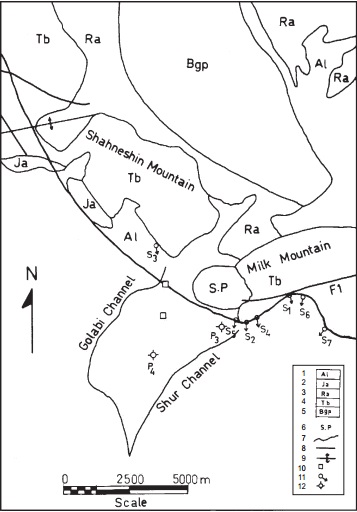The Effect of Darab Salt Dome on the Quality of Adjacent Karstic and Alluvium Aquifers (South of Iran)
DOI:
https://doi.org/10.3986/ac.v31i2.391Povzetek
Zakrasele kraške formacije vsebujejo najpomembnejše vodne vire osrednjih delov jugovzhodnega Irana. Če kraška voda ni onesnažena zaradi slanih dom, je v tem delu Irana njena električna prevodnost pod 500 µS cm-1. Področje raziskav je južno krilo antiklinale Shahneshin-Milk, 200 km vzhodno od Shiraza, ki sodi v narivno cono Zagrosa. Kraška formacija Tarbur (zgornji Campanij-Maastrichtij) izdanja v južnem krilu antiklinale Shahneshin-Milk, pod katero je neprepustna radiolaritna formacija. Solna doma Darab izdanja znotraj zakrasele formacije Tarbur. Iz formacije Tarbur priteka več izvirov. Kvaliteta vode vseh izvirov je v mejah neonesnažene kraške vode razen treh, ki so v bližini solne dome. Električna prevodnost teh treh izvirov je med 1200 in 2000 µS cm-1. Del aluvija okoli solne dome je slano močvirje, ki ga obrobljata dva kanala. Električna prevodnost močvirske vode pod nivojem talne vode je okoli 1400 µS cm-1, v večjih globinah pa se zmanjša na 400 µS cm-1. Odtok s solne dome Darab in prenikanje vode nizke kakovosti iz kanala sta najbrž glavna vzroka za nastanek slanega močvirja. Pomemben delež onesnažene kraške vode iz Tarburja ne teče proti močvirju, saj, prvič, večina kraške vode iz Tarburja priteka na dan skozi izvire, in drugič, na globlje plasti aluvijalnega vodonosnika onesnažena voda ne vpliva.
Karstified carbonate formations are among the most important water resources in the south-central regions of Iran. If the karst water is not contaminated by salt domes, the electrical conductivity of water in the karst aquifer is less than 500 µS cm-1 in the south-center of Iran. The study area is located in the southern flank of Shahneshin-Milk anticline, 200 km east of Shiraz. This region is situated in the Zagros Thrust Zone. The Tarbur karstic formation (Late Campanian-Maastrichtian) is outcropped on the southern flank of the Shahneshin-Milk anticline which is underlain by the impermeable Radiolarite formation. The Darab salt dome outcrops inside the karstified Tarbur Formation. Several springs emerge from the Tarbur Formation. The quality of all springs is in the range of unpolluted karst water except for three springs which are located near the Darab salt dome. The electrical conductivity of these springs range from 1200 to 2000 µS cm-1. Part of the alluvium near the Darab salt dome is salt-marsh which is bounded by two channels. The electrical conductivity in the salt-marsh below the water table is about 1400 µS cm-1, and it reduces to 400 µS cm-1 at the lower depths. Run-off from the Darab salt dome and seepage from the channel with low quality water are probably the main reasons of salt-marsh development. A considerable amount of polluted Tarbur karst water does not flow towards the marshland because, firstly, most of the Tarbur karst water discharges from the springs, and secondly, the alluvium aquifer is not affected by polluted water at lower depths.
Prenosi

Prenosi
Objavljeno
Kako citirati
Številka
Rubrike
Licenca
Avtorji jamčijo, da je delo njihova avtorska stvaritev, da v njem niso kršene avtorske pravice tretjih oseb ali kake druge pravice. V primeru zahtevkov tretjih oseb se avtorji zavezujejo, da bodo varovali interese založnika ter da bodo povrnili morebitno škodo.
Podrobneje v rubriki: Prispevki




